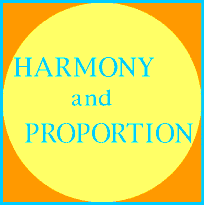Music with Arithmetic, Geometry and Astronomy, made up the Quadrivium, the four ways, or liberal arts, advocated in the Middle Ages as essential for the education of the human being, (together with their outward expression in Grammar, Rhetoric and Logic; the Trivium). Although the educated person would often have learnt to master a musical instrument, it was the mathematical and proportional aspect of music which was held to be of most relevance. Actually playing music, and even composing, because in the creative moment instinctive faculties seemed to have the upper hand, were, at least up to the end of the Middle Ages, seen as inferior to the purity of theory alone.
from The Ten Books of Architecture, continued...
In Chapter VI, Alberti develops the relationship between the proportions of numbers and the measuring of areas.
Methodically, he lists three types of area;
short, middle, and long.The shortest of all is the square, and in this category of short areas he includes, sesquialteria, or fifths, or diapente, and sesquitertia, or fourths, or diatessaron:

"These three Proportions therefore, which we may also call simple, are," he says, "proper for the smaller Platforms."
Then he lists three further Proportions
"Proper for middling Platforms":
First the Double, which he says is best;
second, the Sesqialtera Doubled;
The first is a straightforward:
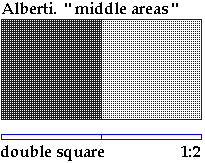
The second is found by taking a square, finding its fifth or sesquialtera, and extending the area by that amount, and then, in turn,extending that area by its fifth:
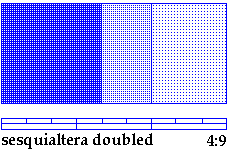
"Thus the Length will exeed the Breadth by a double Proportion plus one Tone more"
The third Proportion is found by doing the same with the square and its Fourth
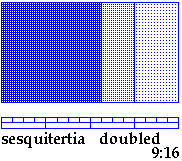
"Here the longer Line contains the shorter twice, excluding one Tone of that shorter Line."
For his category of "long" areas he lists three: Double Sesquialtera, Double Sesqitertia, and Quadruple.
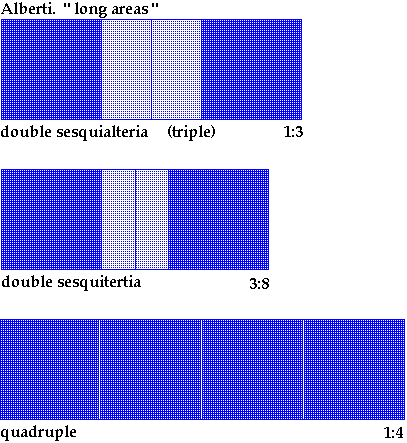
Alberti's own summary:
Short: 1:1, 2:3, 3:4
Middling: 2:4. 4:9, 9:16
Long:1:3, 3:8, 1:4
"By the help of these Mediocrates the Architects have discovered many excellent Things, as well as with Relation to the whole Structure, as to its several Parts; which we have not Time here to particularize. But the most common Use they have made of these Mediocrates, has been however for their Elevations." (p, 200, 1775, Leoni Edition.)
(Note: 18th Nov. 1997: I hope soon to add the sound files which correspond to these areas.)
